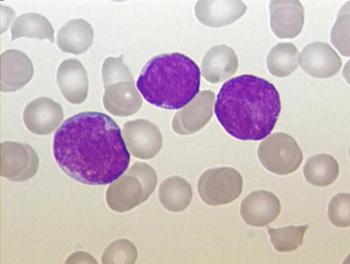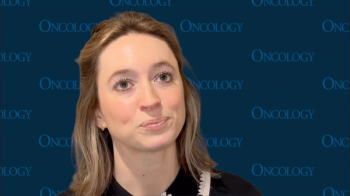
- ONCOLOGY Vol 24 No 4
- Volume 24
- Issue 4
Extranodal NK/T-cell Lymphoma: Basic Questions Remain
Extranodal natural killer/T-cell lymphoma (ENKTL), nasal type, is a distinct entity of non-Hodgkin lymphoma with interesting unique biologic and clinicopathologic features. The tumor is characterized by ethnic preponderance, a consistent association with Epstein-Barr virus (EBV) infection, peculiar histopathologic findings, and a predilection to affect primarily the upper aerodigestive tract, inclusive anatomically of the nasal cavity, nasopharynx, paranasal sinuses, oral cavity, hypopharynx, and larynx. The characteristic clinical features are nasal stuffiness, relentless, nonhealing ulcers, or symptoms due to obstruction of the aforementioned areas. Distant metastasis at time of diagnosis is uncommon.
Extranodal natural killer/T-cell lymphoma (ENKTL), nasal type, is a distinct entity of non-Hodgkin lymphoma with interesting unique biologic and clinicopathologic features. The tumor is characterized by ethnic preponderance, a consistent association with Epstein-Barr virus (EBV) infection, peculiar histopathologic findings, and a predilection to affect primarily the upper aerodigestive tract, inclusive anatomically of the nasal cavity, nasopharynx, paranasal sinuses, oral cavity, hypopharynx, and larynx. The characteristic clinical features are nasal stuffiness, relentless, nonhealing ulcers, or symptoms due to obstruction of the aforementioned areas. Distant metastasis at time of diagnosis is uncommon. However, 10% of patients may present with “extranasal” diseases with inconspicuous upper aerodigestive tract symptoms. Based on a clinicopathologic study of 136 patients, the recent International Peripheral T-cell Lymphoma Project found that the outcome of patients with extranasal disease is much worse than for those with nasal disease, with a median overall survival of 0.36 vs 1.6 years (P < .001).[1]
The Revised European-American Classification of Lymphoid Neoplasms (REAL), invented by a group of expert hematopathologists in 1994, has stimulated investigators around the globe to look into ENKTL as a distinct separate entity of lymphoma. Since then, considerable progress has been made in the understanding of the biology of ENKTL, particularly with regard to the role of EBV in malignant transformation. In contrast, little progress has been made regarding the optimal strategy of treatment, so that in 2010 there remains a lack of consensus on treatment of ENKTL and no therapy is considered standard. Almost all of the published reports have been limited by small sample sizes, and nonrandomized studies have included a heterogeneous patient population or patients treated with a wide range of treatment modalities.
Role of Radiation
As radiation was the principal therapy when the disease was formerly known as lethal midline granuloma, radiotherapy is, for the past 20 years, the mainstay of treatment for patients with limited-stage ENKTL, nasal type. Experience from most large series studies showed that the overall response rate was over 80% with a complete remission rate of 70% when radiation was given as a sole therapy to patients with limited-stage disease.[2,3] However, only 30% to 40% of these patients enjoyed long-term survival, as relapses-both local and systemic-were reported in up to 25% to 50%. The use of chemotherapy or a combination of chemotherapy and radiation to ameliorate the rate of relapse therefore deserves further exploration.
Given that standard treatment for patients with early-stage, diffuse large-cell lymphoma is chemotherapy followed by involved-field radiation, it is not surprising that several centers advocated this treatment strategy for patients with limited-stage ENKTL, nasal type. Using a brief course of anthracycline-based chemotherapy followed by radiation, the 5-year overall survival rate was only 50% for patients with localized ENKTL.[4,5] However, studies using upfront radiation followed by chemotherapy reported a far better outcome, with a complete response rate greater than 80% and a 5-year overall survival rate of 67% to 77%.[3,6] Studies of anthracycline-based chemotherapy without radiation are disappointing because of high rates of refractory disease. A mechanism postulated for a high failure rate after chemotherapy is high p-glycoprotein (P-gp) expression in NK lymphoma cells, which results in drug efflux and intracellular decrease of cytotoxic agents-in particular, vincristine and doxorubicin, the two main components in the CHOP regimen (which also includes cyclophosphamide and prednisone).
Systemic Chemotherapy
Systemic chemotherapy is essential in patients with stage III/IV extranasal or relapsed/refractory ENKTL. To overcome the intrinsic multidrug resistance (MDR)-mediated chemotherapy resistance of ENKTL, investigators proposed novel chemotherapy regimens including non–P-gp efflux medications and etoposide, which is effective for EBV-associated lymphoproliferative diseases. Experiences with SMILE (steroid dexamethasone, methotrexate, ifosfamide, asparaginase [Elspar], etoposide) or the other asparaginase-based regimen showed complete response rates of about 50% and an overall response rate of 70% in patients with advanced or relapsed/refractory ENKTL.[7,8]
Another approach is to apply the concept of concurrent chemoradiotherapy, which has been established as a standard therapy for several types of solid tumors. Yamaguchi et al and Kim et al treated newly diagnosed ENKTL, stage IE/IIE with concurrent chemoradiotherapy and reported complete response rates of 77% and 83% with manageable toxicities.[9,10]The 2- to 3-year progression-free survival rates were 67% and 85%. The definitive roles of these promising chemotherapeutic regimens are being actively explored in a number of institutions. Although previous reports favored autologous hematopoietic stem cell transplant (HSCT) performed during first complete response, the role of HSCT in patients with ENKTL remains inconclusive because of inadequate data.
As in most other lymphoma entities, the rationale for treatment of ENKTL should be based on the relevant prognostic stratification. Unfortunately, the International Prognostic Index (IPI) could not separate stage I ENKTL patients into those with or without local tumor invasiveness. Italian and Korean investigators recently proposed new prognostic models for ENKTL. However, there is still room for a more relevant model that incorporates important biologic parameters such as EBV-DNA levels and the findings of whole-body positron-emission tomography (PET) scanning with other existing prognostic features.
Conclusion
With his review in this issue of ONCOLOGY, Au has provided a recent update on the clinicopathologic features and current approaches to the treatment of patients with ENKTL. The review also challenges us with an algorithm for the work-up and treatment of patients newly diagnosed with ENKTL, nasal type. Despite our gain in better understanding the disease over the past decade, we are still confronted with the most basic questions for the management of ENKTL: What is the standard treatment for ENKTL, both limited- (particularly in patients with a large tumor burden) and advanced-stage disease? What is the definitive role of the newly devised non–anthracycline-based chemotherapy regimen? What is the role of HSCT and novel therapy? These questions will not be answered without cooperative efforts conducted through the multinational, multicenter, large randomized controlled trials.
-Tanin Intragumtornchai, MD
Financial Disclosure:The author has no significant financial interest or other relationship with the manufacturers of any products or providers of any service mentioned in this article.
References:
References
1. Au WY, Weisenburger DD, Intragumtornchai T, et al: Clinical differences between nasal and extranasal natural killer/T-cell lymphoma: A study of 136 cases from the International Peripheral T-Cell Lymphoma Project. Blood 23:3931-3937, 2009.
2. Kim GE, Lee SW, Chang SK, et al: Combined chemothearpy and radiation versus radiation alone in the management of localized angiocentric lymphoma of the head and neck. Radiother Oncol 61:261-269, 2001.
3. Li XY, Yao B, Jin J, et al: Radiotherapy as primary treatment for stage IE and IIE nasal natural killer/T-cell lymphoma. J Clin Oncol 24:181-189, 2006.
4. Kim WS, Song SY, Ahn YC, et al: CHOP followed by involved field radiation: Is it optimal for localized nasal natural killer/T-cell lymphoma? Ann Oncol 12:349-352, 2001.
5. Cheung MM, Chan JK, Lau WH, et al: Early stage nasal NK/T-cell lymphoma: Clinical outcome, prognostic factors, and the effect of treatment modality. Int J Radiat Oncol Biol Phys 54:182-190, 2002.
6. Huang MJ, Jiang Y, Liu WP, et al: Early or up-front radiotherapy improved survival of localized extranodal NK/T-cell lymphoma, nasal-type in the upper aerodigestive tract. Int J Radiat Oncol Biol Phys 70:166-174, 2008.
7. Yamaguchi M, Suzuki R, Kwong YL, et al: Phase I study of dexamethasone, methotrexate, ifosfamide, L-asparaginase, and etoposide (SMILE) chemotharpy for advanced-stage, relapsed or refractory extranodal natural killer (NK)/T-cell lymphoma and leukemia. Cancer Sci 99:1017-1020, 2008.
8. Yong W, Zheng W, Zhu J, et al: L-asparaginase in the treatment of refractory and relapsed extranodal NK/T-cell lymphoma, nasal type. Ann Hematol 88:647-652, 2009.
9. Yamaguchi M, Tobinai K, Oguchi M, Ishizuka N, Kobayashi Y, Isobe Y, et al. Phase I/II study of concurrent chemoradiotherapy for localized nasal natural killer/T-cell lymphoma: Japan Clinical Oncology Group Study JCOG0211. J Clin Oncol 27:5594-5600, 2009.
10. Kim SJ, Kim K, Kim BS, et al: Phase II trial of concurrent radiation of concurrent radiation and weekly cisplatin followed by VIPD chemotherapy in newly diagnosed, stage IE to IIE, nasal, extranodal NK/T-cell lymphoma: Consortium for improving survival of lymphoma study. J Clin Oncol 27:6027-6032, 2009.
Articles in this issue
over 15 years ago
Capsaicinover 15 years ago
Role of Obesity and Exercise in Breast Cancer Survivorsover 15 years ago
Current Management of Nasal NK/T-cell Lymphomaover 15 years ago
Nasal NK/T-cell Lymphoma: Where Are We Now?Newsletter
Stay up to date on recent advances in the multidisciplinary approach to cancer.

















































































